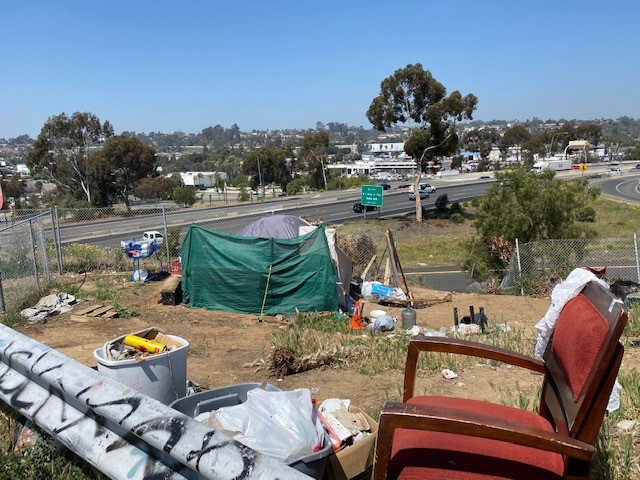Right now, an unincorporated section of El Cajon is the sight of a notorious homeless encampment, and as NBC 7’s Artie Ojeda reports, a small group of people living there could be forced out.
Homelessness in San Diego has grown by at least 10% since 2020, the Regional Task Force on Homelessness revealed Thursday by releasing its 2022 WeAllCount Point-in-Time Count, a one-day snapshot of the minimum number of San Diegans living in emergency shelters, transitional housing, safe havens and on streets and along riverbeds.
The count found 8,427 people experiencing homelessness across San Diego County, a minimum number.
"The challenges of finding every person in a car, canyon, or under a bridge, is impossible, but every effort is made to find and engage as many people as we can," a statement from the RTFH read.
This number included 4,106 unsheltered San Diegans, with 4,321 individuals in shelters. Of those surveyed, 85% said they had fallen into homelessness while living in the region.
Get top local stories in San Diego delivered to you every morning. Sign up for NBC San Diego's News Headlines newsletter.
Breaking Point
The PITC was conducted this year in February by more than 1,400 volunteers across the county. It was the first such count since January 2020, before the negative impacts of the COVID-19 pandemic and by the subsequent increase in shelter options.
The Regional Task Force on Homelessness said comparisons between 2020 and 2022 should not be measured by the same standard and that heavy rains the night before and frigid temperatures the morning of the count may have impacted the number of people sleeping outside. Still, the total number of people sleeping outside without shelter increased by 3%.
"These data points give context to a crisis we already see with our own eyes," said Supervisor Terra Lawson-Remer, who represents the county on RTFH's Continuum of Care Advisory Board. "The homelessness crisis has changed a lot in two years, and with this information we can do a better job of providing the right kind of help based on people's unique problems, or better yet, make sure they never lose their home in the first place."
There are some bright spots in the data, the task force claims, including a 30% decrease in the veteran homeless population and a 7% decrease in the chronic homlessness population versus 2020. The county also saw an increase in transitional aged youth in shelters. Additional shelter options throughout the region also made a difference as well as a large housing effort in downtown San Diego housing roughly 150 San Diegans the week leading up to the count.

"The latest numbers confirm what we all see and what we hear from members of our community every day -- that our homelessness crisis is getting worse," said San Diego Council President Sean Elo-Rivera. "We must take every opportunity, explore every idea and do all we can to house the unsheltered and prevent more San Diegans from falling into homelessness.
"Housing is a human right and we in positions of leadership have a moral obligation to make next year's Point in Time Count a demonstration of progress toward the realization of that right," he said.
Deacon Jim Vargas, president and CEO at Father Joe's Villages, one of San Diego's largest homelessness services providers, said problems could compound with increasing cost of living.
Get updates on what's happening in San Diego to your inbox. Sign up for our News Headlines newsletter.
"These numbers reflect the increase in need for affordable housing and comprehensive programs amidst the rapid inflation and skyrocketing rent and housing prices in San Diego," he said. "When the cost of living goes up, more people are susceptible to enter or be at risk of homelessness.
"Right now, with the line for our food pantry stretching a quarter mile long, we know people are being heavily impacted by inflation and housing costs," Vargas said. "Low-income families are more susceptible than ever to fall into homelessness."
The Point-in-Time Count saw an increase in families experiencing homelessness, up 56% from 2020. Black San Diegans, who make up under 5% of the total population in San Diego County, made up 24% of the region's unsheltered homeless population.
"The Point-in-Time Count is about much more than numbers - it's about people," RTFH CEO Tamera Kohler said. "Right now too many people are suffering in San Diego. They're mothers and daughters, fathers and sons. They fell into homelessness due to a lost job, a lost spouse or some other crisis beyond their control.
"Add in the fact that we live in the most expensive housing market in the country, where double digit rent increases are common, and you can see why too many San Diegans are left behind," she said. "The people our volunteers spoke to -- from a senior with Alzheimer's sleeping in a tent, to a family sheltering in their car, to people with a full time job but not enough income to pay rent -- aren't just numbers on a spreadsheet. They're our neighbors, doing their best to survive."
While 24% of San Diegans experiencing homelessness were over 55 in both 2020 and 2022, this year's count showed 47% of those seniors were experiencing homelessness for the first time, with 57% having a physical disability. The oldest person surveyed living on the street in San Diego County was 87.
"Sadly, these numbers are not a surprise," said Serving Seniors CEO Paul Downey. "Based on my personal participation in February's count and on our Needs Assessment survey, combined with the demand for our services, this is exactly what we expected."
According to Kohler, between October 1, 2020 and September 30, 2021, more than 36,500 San Diegans interacted with homeless services, meaning the true number of San Diegans living without permanent housing could be far higher than what the count found.




